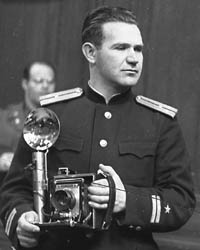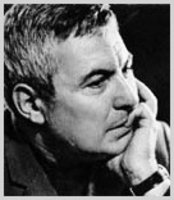Yevgeny Khaldei
Khaldei was also a witness to several pivotal moments in history and is particularly reputed for his photographs during the Nuremberg Trials. He had his hand in liberation of Sevastopol, in taking Novorossiysk by storm, Kerch, in liberation of Romania, Bulgaria, Yugoslavia, Austria, and Hungary. Khaldei worked with the TASS until 1949, when he was fired due to the growing cosmopolitanism. Then he worked as a private freelance photographer, focusing on the scenes from everyday life, and after the war he created a unique gallery of soldiers’ images in peace-time work. After Stalin’s death he got a job again at the newspaper. In 1995, on the Perpignan International Festival of Photojournalism (France), Yevgeny Khaldei was awarded the most honorable award in the art world — the title of the Knight of the Order of Arts and Letters. In 1997, The Witness of History. Photos by Yevgeny Khaldei book was published by the American Aperture. Also in May 1997, the 60-minute film, Yevgeny Khaldei — A Photographer of the Stalin era, opened. In 2004, Editions Du Chene — Hachette Livre, PH (France) has published the book of Mark Grosse, Khaldei. Photographer of the Soviet Union (Khaldei. Un Photoreporter en Union Sovietique).
Dmitry Baltermants
In 1915, after the World War I began, the family moved to Moscow. After the death of Dmitry’s stepfather, his mother took a job as a typist in the Foreign Literature Publishing House. At the same time, a fourteen-year teenager, Dmitry began his career. The boy managed to try his hand at a variety of areas, but with particular pleasure he found himself in places where he could deal with the photo. For several years, Dmitry assisted to several well-known photographers, helped arrange the showcases in Izvestia PH, worked as a typesetter in a printing house, as a projectionist, and assistant architect. On duty, the boy had a chance to get acquainted with the photos, which were distinguished by high artistic value and were a true work of art in the style of socialist realism. After graduating Mechanics and Mathematics Faculty of Moscow State University in 1939, Dmitry Baltermants was a lecturer of mathematics at the Higher Military Academy with the rank of captain. In the same year a young man on commission of Izvestia newspaper made his first professional photos, capturing the entry of the Soviet troops on the territory of Western Ukraine. That trip has decided the fate of Baltermants, he joined the staff of Izvestia newspaper and became a professional photographer. According to the memoirs of his daughter, a photographer Tatyana Baltermants, before taking a momentous decision, Dmitry Baltermants almost did not hesitate, “It took a little time on cooling-off — the soul has been already poisoned with a photograph, and he still had to take a camera”. Immediately after the outbreak of the Great Patriotic War, Dmitry Baltermants went to the front as a photographer for Izvestia newspaper. The newspaper featured reports, devoted to the construction of anti-tank fortifications of Moscow, the defense of the capital, the fighting in the Crimea, the Battle of Stalingrad. Dmitry’s collaboration with Izvestia finished very sad for the photographer, in 1942. At that time Baltermants returned to the capital for a few days, to show and print photos taken at Moscow and Stalingrad. The photos were left to dry in the office. At night the paper's management decided to put one of them into the morning publication. In the rush they randomly had chosen the Moscow photo that was published with the caption Captured Germans out of Stalingrad. When selecting the picture Dmitry was out, but after the mistake was discovered, the entire responsibility was placed on him. Baltermants was demoted in rank and sent to a penal battalion. The photographer saved his life thanks to the serious injury, which threatened the amputation of his leg. After lying in a hospital until 1944, Dmitry Baltermants went again to the front as a photographer – not for Izvestia, but for The defeat of the enemy army newspaper. Returning from the front with orders, medals and hundreds of publications and archives of thousands of negatives, Dmitry Baltermants found a job not at once. Service in a penal battalion and Jewish origins in the era of an emerging campaign against cosmopolitanism closed doors for the photographer even of those editions, where they highly regarded and loved his work. Responsibility to hire Baltermants took over only the poet, Alexey Surkov, the chief editor of Ogonyok - the largest Soviet illustrated edition, which came out in the millions. In this magazine, since 1965, heading its photo department, Dmitry Baltermants had been working until his death. During the Khrushchev Thaw Dmitry Baltermants experienced real heyday of his popularity. At that time the Soviet amateurs were able to see many of the archives, the front works not printed at one time, capturing not only the feat, but death, grief, hardships of the war. The photographer became well-known even abroad – personal exhibitions of Dmitry Baltermanta in London (1964) and New York (1965) made him world famous. The photographer willingly used photo collages. For example, the famous wartime photograph Grief in its final version, published in 1975, acquired in its upper part the heavy clouds that had been typed from another frame. As a result, the picture is a convincing example of a skillful combination of stunning reportage on the power of documentary images with a “borrowed” component even today. The picture, embodying exhausted women trying to find their relatives’ bodies in the freed from the enemy Kerch, bypassed booths of domestic and international exhibitions, and was published in many publications.
By the Soviet standards, career of Baltermants was very successful – he was shooting a lot, was published and exhibited, had the opportunity to work abroad, was a member of the jury of prestigious photo contests. Brilliant professionalism, impeccable sense of composition (if Rodchenko invented the diagonal composition, Baltermants the mathematician was a virtuoso of the horizontal one), innate gentility and good relations with the authorities allowed him to remain an independent artist and a cosmopolitan. A unique artistic intuition and the highest skill made his photographs real masterpieces; no matter what he was shooting – stiff bodies in the trenches, a drop of dew on a flower, heroic portraits of workers, endless views of the Volga, the harsh Siberian taiga and Komsomol members, building the BAM (Baikal Amur Mainline) through it.
Unlike many of his contemporaries, Dmitry Baltermants managed to create a visual language, understandable not only to the Soviet, but also to Western experts and the audience. He belongs to a small cohort of Soviet photographers, who gained recognition overseas during the lifetime. He was known and loved by Henri Cartier-Bresson, Josef Koudelka, Marc Riboud, Robert Doisneau and other European masters of photography. |

 Yevgeny Khaldei was born in Yuzovka (now Donetsk, Ukraine). He lost his mother and grandfather during a Jewish pogrom on March 13, 1918, when a bullet passed through his side and into his mother, killing her. He studied in a heder. Khaldei discovered his passion for photography while working in a factory. And at 13 he took his first photo with a self-made camera. By the age of eighteen (1939), Khaldei was working as a staff photographer at the TASS News Agency in Moscow. He took photos of Dneprostroy and Alexey Stakhanov. He represented the TASS on the naval front during the Great Patriotic War. Khaldei covered all 1,481 days of the war between Russia and Germany as a correspondent for the Tass News Agency. Many of his photographs were published at the time, but they have now been compiled into From Murmansk to Berlin, a chronicle of the Russian involvement in the War. He took pictures of Paris meeting of foreign ministers, the defeat of the Japanese in the Far East, a conference of heads of the Allied Powers in Potsdam, and the signing of the surrender document of Germany.
Yevgeny Khaldei was born in Yuzovka (now Donetsk, Ukraine). He lost his mother and grandfather during a Jewish pogrom on March 13, 1918, when a bullet passed through his side and into his mother, killing her. He studied in a heder. Khaldei discovered his passion for photography while working in a factory. And at 13 he took his first photo with a self-made camera. By the age of eighteen (1939), Khaldei was working as a staff photographer at the TASS News Agency in Moscow. He took photos of Dneprostroy and Alexey Stakhanov. He represented the TASS on the naval front during the Great Patriotic War. Khaldei covered all 1,481 days of the war between Russia and Germany as a correspondent for the Tass News Agency. Many of his photographs were published at the time, but they have now been compiled into From Murmansk to Berlin, a chronicle of the Russian involvement in the War. He took pictures of Paris meeting of foreign ministers, the defeat of the Japanese in the Far East, a conference of heads of the Allied Powers in Potsdam, and the signing of the surrender document of Germany. Dmitry Baltermants was born in Poland, Warsaw (still the Russian Empire at that time) on May 13, 1912. He grew up in a prosperous and cultured family: the future photographer’s stepfather was a lawyer; his mother was fluent in several foreign languages.
Dmitry Baltermants was born in Poland, Warsaw (still the Russian Empire at that time) on May 13, 1912. He grew up in a prosperous and cultured family: the future photographer’s stepfather was a lawyer; his mother was fluent in several foreign languages.